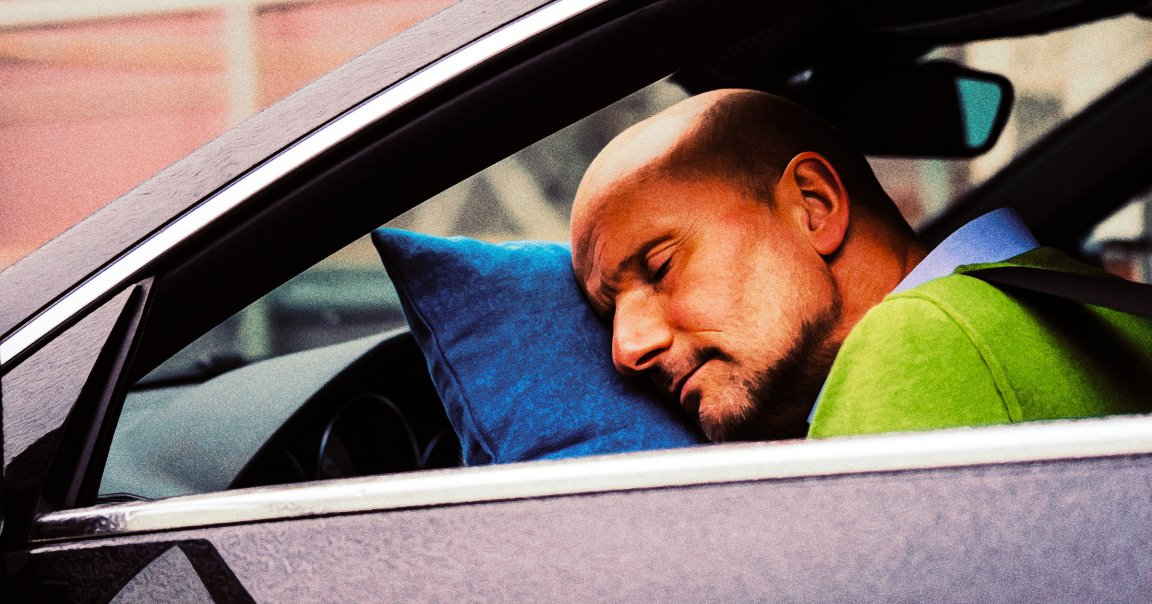
Let’s be clear: Tesla’s cars can’t actually drive themselves without close human supervision. Nonetheless, the automaker labels its most advanced driving mode “Full Self-Driving” (FSD), while its CEO and chief overpromiser Elon Musk explicitly says that they do, in fact, “drive themselves” seemingly every other week.
We shouldn’t even need to say that these misleading impressions of the tech’s capabilities are incredibly dangerous. But if Tesla has a long track record of being reckless, this latest move from it is actively begging for a horrific accident to happen.
According to new reporting from Wired, the Musk-led company has started recommending drowsy motorists to switch over to FSD whenever it detects them falling asleep behind the wheel. These recommendations, per the magazine, are delivered as in-car messages that pop up on the infotainment screen, which owners began noticing earlier this month.
“Lane drift detected. Let FSD assist so you can stay focused,” reads one message cited by the magazine.
“Drowsiness detected. Stay focused with FSD,” read another.
Tesla has had lane-departure warnings for years, But now they’re an unashamed advertisement for FSD, encouraging already half-slumbering drivers to hand over the controls to an unreliable piece of software that lulls them into a false sense of security, if not back to sleep. It’s an approach fraught with contradictions, since, as Tesla warns in the fine print — as well as in the conspicuous “(Supervised)” label it tacked onto the mode’s name — FSD requires you to be constantly alert.
“Tesla is basically giving a series of conflicting instructions,” Alexandra Mueller, a senior research scientist at the Insurance Institute for Highway Safety who studies driver assistance technologies, told Wired. “When you suspect the driver is becoming drowsy, to remove even more of their physical engagement — that seems extremely counterproductive.”
The fundamental problem with any tech that does most of the work for you is that it makes you complacent. If it functions properly most of the time, you’re less likely to be ready to intervene when it does screw up. There’s a name for this phenomenon in aviation, Wired notes: the “out-of-the-loop performance problem,” in which pilots become so accustomed to a plane’s sophisticated systems taking care of everything that they gradually let their guard down and fail to notice when something goes wrong.
“As humans, as we get tired or we get fatigued, taking away more things that we need to do could actually backfire,“ warned Charlie Klauer, a researcher and engineer at the Virginia Tech Transportation Institute, to Wired.
But pilots are highly trained individuals who fly for a living, and they often have a copilot. Tesla drivers — specifically the kind that would use FSD — are Musk fans that believe in his overblown promises so much that they’re literally willing to put their life on the line to help iron out the kinks in a piece of software that has a habit of trying to drive straight into oncoming trains. Many of them, we should add, have already been caught on camera taking a nap at wheel.
It’s an especially eyebrow raising moment for Tesla to begin brazenly recommending FSD to drowsy drivers. In August, it was ordered to pay $329 million in damages after a car running an older version of its driving software, Autopilot, blazed through an intersection at 60 miles per hour and killed a young woman.
It’s also the subject of a federal investigation that launched after multiple reports of its cars crashing while running FSD — including one incident in which a Tesla’s onboard camera clearly shows it mowing down an elderly pedestrian on the side of the road while a beam of sunlight washed out its view.
And its misleading statements haven’t gone unnoticed by local regulators, either: the California DMV sued the EV company for false advertising, pointing to FSD’s misleading name. All the while, its struggling Robotaxi service that launched this summer in Austin, Texas, has only emphasized just how faulty its driving tech remains, with the purportedly autonomous cabs blundering into several accidents. Talk about a wake-up call.
More on Tesla: Tesla Fans Try Coast-to-Coast Self-Driving Trip, Crash Almost Immediately